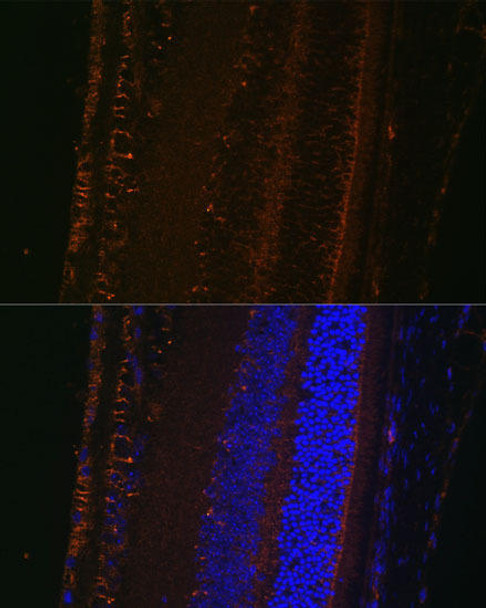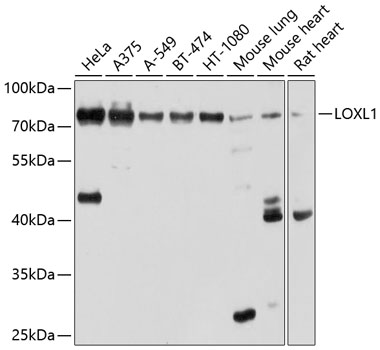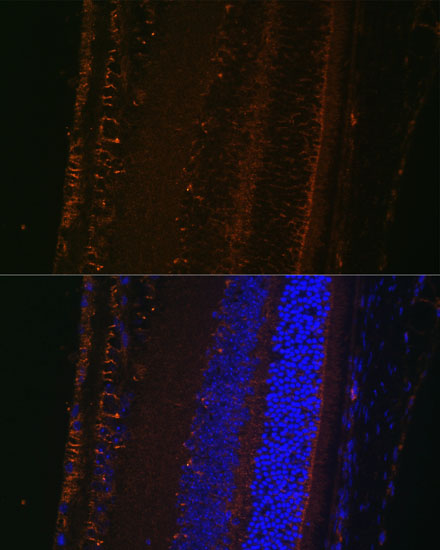Anti-LOXL1 Antibody (CAB10191)
- SKU:
- CAB10191
- Product type:
- Antibody
- Reactivity:
- Human
- Mouse
- Rat
- Host Species:
- Rabbit
- Isotype:
- IgG
- Antibody Type:
- Polyclonal Antibody
- Research Area:
- Cell Biology
Frequently bought together:
Description
| Antibody Name: | Anti-LOXL1 Antibody |
| Antibody SKU: | CAB10191 |
| Antibody Size: | 20uL, 50uL, 100uL |
| Application: | WB IF |
| Reactivity: | Human, Mouse, Rat |
| Host Species: | Rabbit |
| Immunogen: | Recombinant fusion protein containing a sequence corresponding to amino acids 95-370 of human LOXL1 (NP_005567.2). |
| Application: | WB IF |
| Recommended Dilution: | WB 1:1000 - 1:3000 IF 1:50 - 1:200 |
| Reactivity: | Human, Mouse, Rat |
| Positive Samples: | HeLa, A375, A-549, BT-474, HT-1080, Mouse lung, Mouse heart, Rat heart |
| Immunogen: | Recombinant fusion protein containing a sequence corresponding to amino acids 95-370 of human LOXL1 (NP_005567.2). |
| Purification Method: | Affinity purification |
| Storage Buffer: | Store at -20°C. Avoid freeze / thaw cycles. Buffer: PBS with 0.02% sodium azide, 50% glycerol, pH7.3. |
| Isotype: | IgG |
| Sequence: | RQAP SLPL PGRV GSDT VRGQ ARHP FGFG QVPD NWRE VAVG DSTG MARA RTSV SQQR HGGS ASSV SASA FAST YRQQ PSYP QQFP YPQA PFVS QYEN YDPA SRTY DQGF VYYR PAGG GVGA GAAA VASA GVIY PYQP RARY EEYG GGEE LPEY PPQG FYPA PERP YVPP PPPP PDGL DRRY SHSL YSEG TPGF EQAY PDPG PEAA QAHG GDPR LGWY PPYA NPPP EAYG PPRA LEPP YLPV RSSD TPPP GGER NGAQ QGRL SVGS VYRP NQNG RGLP |
| Gene ID: | 4016 |
| Uniprot: | Q08397 |
| Cellular Location: | Secreted, extracellular space |
| Calculated MW: | 63kDa |
| Observed MW: | 80kDa |
| Synonyms: | LOXL1, LOL, LOXL |
| Background: | This gene encodes a member of the lysyl oxidase family of proteins. The prototypic member of the family is essential to the biogenesis of connective tissue, encoding an extracellular copper-dependent amine oxidase that catalyzes the first step in the formation of crosslinks in collagen and elastin. The encoded preproprotein is proteolytically processed to generate the mature enzyme. A highly conserved amino acid sequence at the C-terminus end appears to be sufficient for amine oxidase activity, suggesting that each family member may retain this function. The N-terminus is poorly conserved and may impart additional roles in developmental regulation, senescence, tumor suppression, cell growth control, and chemotaxis to each member of the family. Mutations in this gene are associated with exfoliation syndrome. |
| UniProt Protein Function: | LOXL1: Active on elastin and collagen substrates. Genetic variations in LOXL1 are a cause of susceptibility to exfoliation syndrome (XFS); also called exfoliation glaucoma (XFG). XFS is a disorder characterized by accumulation of abnormal fibrillar deposits in the anterior segment of the eye. In addition to being a cause of glaucoma and glaucomatous optic neuropathy, exfoliation syndrome has also been associated with lens zonule weakness, cataract formation, and systemic vascular complications due to deposition of exfoliation material in extraocular tissues. Susceptibility to exfoliation syndrome is conferred by a risk haplotype that includes two LOXL1 coding non-synonymous SNPs (Arg141Leu and Gly153Asp) and one intronic SNP. Arg141Leu and Gly153Asp are sufficient to confer disease susceptibility in some populations. Belongs to the lysyl oxidase family. |
| UniProt Protein Details: | Protein type:EC 1.4.3.-; Extracellular matrix; Oxidoreductase; Secreted; Secreted, signal peptide Chromosomal Location of Human Ortholog: 15q24.1 Cellular Component: extracellular matrix; extracellular region Biological Process: extracellular matrix organization and biogenesis; protein amino acid deamination Disease: Exfoliation Syndrome |
| NCBI Summary: | This gene encodes a member of the lysyl oxidase family of proteins. The prototypic member of the family is essential to the biogenesis of connective tissue, encoding an extracellular copper-dependent amine oxidase that catalyzes the first step in the formation of crosslinks in collagen and elastin. The encoded preproprotein is proteolytically processed to generate the mature enzyme. A highly conserved amino acid sequence at the C-terminus end appears to be sufficient for amine oxidase activity, suggesting that each family member may retain this function. The N-terminus is poorly conserved and may impart additional roles in developmental regulation, senescence, tumor suppression, cell growth control, and chemotaxis to each member of the family. Mutations in this gene are associated with exfoliation syndrome. [provided by RefSeq, Jan 2016] |
| UniProt Code: | Q08397 |
| NCBI GenInfo Identifier: | 189031484 |
| NCBI Gene ID: | 4016 |
| NCBI Accession: | Q08397.2 |
| UniProt Secondary Accession: | Q08397,Q6NUL3, Q96BW7, |
| UniProt Related Accession: | Q08397 |
| Molecular Weight: | 63kDa |
| NCBI Full Name: | Lysyl oxidase homolog 1 |
| NCBI Synonym Full Names: | lysyl oxidase like 1 |
| NCBI Official Symbol: | LOXL1 |
| NCBI Official Synonym Symbols: | LOL; LOXL |
| NCBI Protein Information: | lysyl oxidase homolog 1 |
| UniProt Protein Name: | Lysyl oxidase homolog 1 |
| UniProt Synonym Protein Names: | Lysyl oxidase-like protein 1; LOL |
| Protein Family: | Lysyl oxidase |
| UniProt Gene Name: | LOXL1 |










